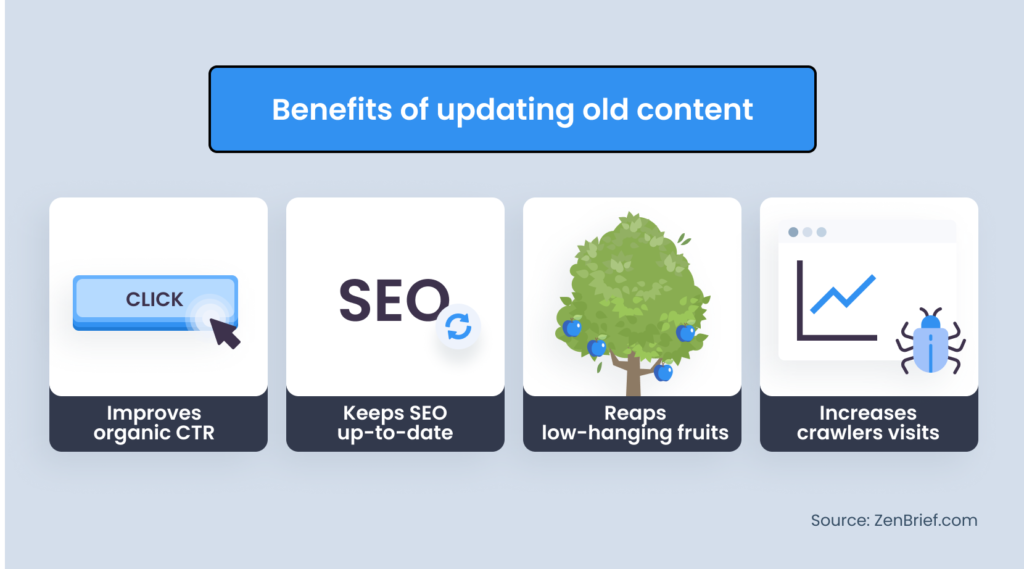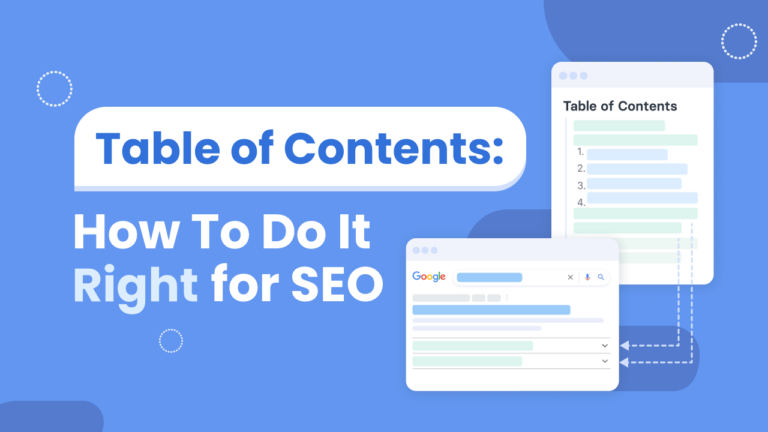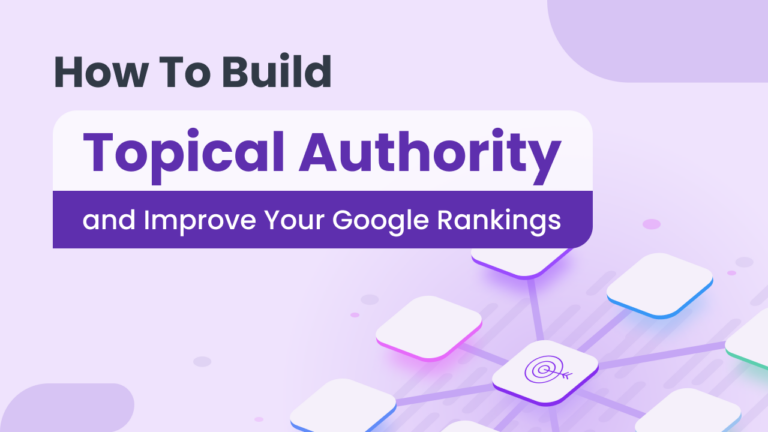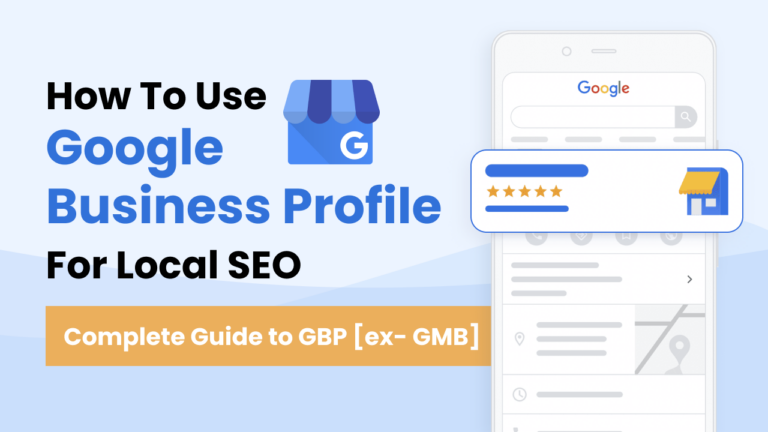There is a secret SEO weapon that only a few people in the industry are using to boost their organic traffic.
No, it’s not writing new content daily or keeping up with Google’s 200+ parameters for ranking.
It’s much simpler than that.
All you have to do is update and optimize your existing content and make it keep working for you.
The day your content makes it to page one of Google is one of the most exciting for every website owner. But with two million-plus blog posts being published every day, your work has to fight hard every day just to maintain its position. According to Moz, all content gradually becomes less fresh and eventually starts going lower and lower on the search engine. Ignoring this is one of the biggest on-site SEO mistakes.
How do you stop this from happening?
Whether your content is evergreen or not, you have to periodically update your old content and give it a fresh boost. more attention, and republish the work. It is the best way to enhance the effectiveness of your SEO efforts and boost your organic traffic. Besides ensuring your old content doesn’t get buried under the rubble that is millions of blog posts daily, you also get more reward for less work.
In this article, we look into how you can optimize your old content for better rankings and conversions and discuss the benefits of doing so.
Why Is Updating Your Existing Content Important?
Here are the benefits of reviving your old content.

1. It improves your click-through rate
If you do a quick search for any word or phrase, you will notice the top results were published recently, mainly within the last one year or so, with very few exceptions. This is because people are more likely to click on a post published recently than an older one.
For example, if you google something like, ‘best phone for vlogging’, you want phones that are currently in the market, not the ones that were reviewed three or four years ago. The publishing date on your content not only makes google rethink your ranking position but it also increases your click-through rate.
2. It helps you keep up with SEO
Google updates its algorithm more times than you do your clothes. Some of the changes have huge effects on ranking, so it’s important to keep up with them. While your 10-year-old content may still be relevant and helpful today, a lot has changed in SEO since then, which will undoubtedly affect your ranking. Maybe you can update your headline, add some relevant keywords, use a description that grabs more attention, and republish the work. Improving your old content with some of those changes makes google crawlers swing by your place more often and help you rank. And if your content is ranked in a top spot, such as in Google’s Featured Snippet, or in other Google’s position-zero spots it’s important to keep updating it to make sure no competitor replaces it.
3. Updating old content is easier than creating new content
With millions of blog posts coming up every single day, you will agree that it’s an uphill task to rank on the first or second page of Google, which is where you want to be. New content can take months or even years to see the light of day. You have a better chance of ranking well with old content that was already working its way up if you do a few retouches. Think about some of your posts that have done well in the past and give them a fresh boost so they can go back on top. This takes less effort than creating new content, and it works even better. While reviewing old content, you may even be able to spot low-hanging fruits, such as internal linking opportunities that strengthen your topical authority.
4. It improves how often Google indexes your site
As you update some of the old posts on your site, you will be boosting your entire site as well. This is because Google looks at the whole site to see the recent updates, and it’s one of the metrics they use to assign how much time crawlers will spend on your site. The more crawlers show up to your site, the more likely your content will show up on top search results.
How Often Should You Update Your Existing Content?
How often you update your existing content depends on the nature of your site and business. Some sites need to be updated more frequently than others due to the dynamic nature of their content. For example, if you own an online casino affiliate site whose content is all about keeping readers updated on the best casinos, best bonuses, and tournaments, you may have to update your content once a week to keep the information accurate.
On the other hand, if the content is about losing weight, growing long hair, making money, and so on, once a month is sufficient because not much will change in that arena. When dealing with informational content like these, your updates will involve more SEO updates than altering the actual content. You may want to add some keywords, optimize the title, improve the call to action, and so on.
How to Optimize Old Blog Posts for SEO
You now know it’s imperative to update your existing content periodically to boost your organic traffic. But what exactly will you be updating? Here is a step-by-step approach on what to do with your old blog posts to turn them back into gold.
1. Take content inventory
First things first, you have to collect data on which posts to optimize. Ideally, it should be all of them, but it’s good to know where you will start. One easy way to do that is go to your Google Analytics under Behavior > Site Content > all Pages to find the most popular posts on your site. Be sure to also check things like bounce rate and average time on the page.
You can also use Screaming Frog and ContentKing to get this data. Export all this information to a spreadsheet.
To that, add pages with the most links, which you will find within your Google Search Console under Links. Include also conversions per page, social shares, rankings, and any other metric that determines the success of your posts.
With this data at hand, you can figure out the right pages to update. To begin with, go with:
- Posts with high traffic but low conversion because they have the potential to bring in more sales if optimized.
- Posts with low traffic but high conversion to increase leads.
- Former popular content that seems to have lost their shine.
Pick 10 posts at the beginning and work your way up. In addition to all these, you should also look out for posts whose goal or audience isn’t clear. Every blog post should have a target audience and a definite goal. When a person types in a particular word, phrase, or question, what is their intent? This will help you to meet that need.
2. Update Your Keywords
At the backbone of every SEO strategy is the right keyword. A keyword or phrase that was used a year ago may not bring the same amount of organic traffic today, so it’s important to re-evaluate that. The placement of the keyword and how it fits in your keywords clustering strategy also matters. One of the biggest mistakes people make is using too many keywords in a post or not optimizing any keyword, which confuses Google bots.
As we have explained in another article, Google Search Console is a great tool for SEO. To find the very best keywords for your content:
- Go to Google Search Console > Performance
- Go to the Filter rows icon, select Position> Smaller than, and put in 21
- Check the search queries that show up and click Pages to see the pages that show up. Alternatively, you can put your posts on Google Keyword Planner and see the suggested keywords for it. With these tools, you can see some of the phrases you haven’t optimized for, especially long-tail keywords, which are often easier to rank
Alternatively, you can put your posts on Google Keyword Planner and see the suggested keywords for it. With these tools, you can see some of the phrases you haven’t optimized for, especially long-tail keywords, which are often easier to rank.
ZenBrief’s Google Search Console integration can also be a powerful tool to update your keywords. You can see which search queries you may have overlooked, how well your current content covers it compared to your competition.
At the risk of coming off as a broken record, main keywords must be used in your title, Meta description, H1, body content, internal links, and images. Speaking of broken records, do not stuff your content with keywords because that makes for a poor user experience.
3. Improve Click-Through-Rate
Another fantastic strategy to improve organic traffic is to up your click-through rate. We have talked about how a recent date of publishing contributes to people clicking the post because they assume it’s current. Other ways to improve your click-through rate include;
- Improve your headline. According to Copyblogger, a good headline or title is the number one way to make people click on your post. Besides knowing the user intent of the reader, you can use tools like headline analyzer and Headline Hacks to create impressive titles. Make sure you include power words, numbers, and keywords in the title.
- Answer the question. Many Google users ask Google a question. If you can accurately and comprehensively answer that question, Google may answer it directly from your site, making your post the first one people will see.
- Play with the Meta description. The Meta description is a brief explanation of what you will get when you open that post. You will see it under every post when you search for a phrase on google. Make sure it’s captivating, informative, and includes the keywords.
4. Update the Content
There is incredible value in updating and rewriting the actual content. Think about some of the changes that have taken place since you wrote that piece. Updating it keeps the information current and accurate. For example, the minimum wage in the Netherlands gets adjusted twice a year, most apps and programs also get upgraded a couple of times annually. If you don’t update these changes in your content, you risk giving your readers information that is old and inaccurate.
ZenBrief’s content audit feature can also help you identify ways to leverage your old content to drive more organic traffic to your site. It connects to your Google Search Console, and helps you identify low-hanging fruits. From there,you can easily create a content brief that will contain all the information you need to update your content.
Other updates you may want to check include;
- Broken links. Since the day you published the content, there is a chance that some of the outbound links you included do not exist anymore, or their URLs have changed. Removing these links and replacing them with current and existing pages improves your SEO and credibility.
- Grammar and spelling. Ever read a post you wrote months ago and got hit by a cringe-worthy spelling mistake? This is why it’s important to go through your past work later with a fresh pair of eyes. While spelling and grammar mistakes are not among Google’s 200 ranking factors, they make for a poor reading experience.
- Add fresh visuals. One of the better ways to improve your ranking is by adding different types of media. As content becomes more diverse, there is a need to place different types of images, audio, graphs, and videos to your content. Maybe you just had a featured image and one more to break the monotony in your original content. As you update, you have a chance to add a new YouTube video you have done on the topic, add illustrations and other relevant images.
- Add internal links. Since you posted the original blog post, you have probably done a number of articles that you can link back to. We wrote about how internal links can be a powerful strategy to build authority. Internal links help the reader to spend more time on your site, which helps tremendously with ranking. ZenBrief’s internal links suggestions feature can help you save a lot of time.
- Content pruning. As you read back your content, you will notice that some of the information is irrelevant and outdated. Removing such fluff removes the distraction and helps the reader to see the more important information you have included. Sometimes, less is more, so some pruning may do your content good.
- Answer more questions. When you wrote the original piece, you only wrote what was within your reach and knowledge at the time. Over time, you learn more and see questions customers ask that could be a great resource of information for your content. As you learn more information on the topic and learn about the customers more, try to answer as many questions as possible in your post. ZenBrief’s content brief feature shows you all the questions you should be answering.
5. Keep up with Google Updates
Every year, there are at least 600 Google Updates focused on improving the algorithm and the ranking factors. Some of these changes can have a huge impact on your content, but some are simply improvements. A while back, an unconfirmed change nicknamed ‘Fred’ caused widespread havoc to sites with short articles and keyword-stuffed posts. This of course wasn’t a shock to many as SEO experts have warned against short content and keyword stuffing, among other Google updates.
The only way you can guarantee, at least for the time being, that your content is safe and will bring in organic traffic is to keep up with Google updates. Ensure you find out what those changes are, what Google’s best practices are, and update your content to feature those changes. For example, if your original article was only 500 words long, it may be time to increase that word count to double or triple to meet the current standards. If you are a ZenBrief user, use the Content Audit feature to see which pages have become too light and need more content depth.
6. Improve your Call to Action
If your existing content is more than a few months to a year old, chances are the call-to-action is outdated. Even if your post ranks well but the call to action is bad, you won’t get decent leads, which is not good for business. Maybe you have a better lead generation trick you didn’t have previously or a new product that fits the blog post even better. Maybe you have upgraded your marketing skills, and you know how to write better CTAs.
To make your CTAs stand out, it’s crucial to rethink the search intent what does the reader want from your blog post? What were they looking for? Go back and look at the keywords for your pages and then use them to come with a better call to action.
7. Sort the Comments
The last update you have to take care of before you change the date of your blog post and hit publish again is the comments section. Over time, you might have gotten some comments that don’t really reflect the current standing of your business. This is the time to delete them.
Perhaps there are important questions that you haven’t answered, or the answer you gave needs to be updated to the current position. The comment section may not have as much power as the content and the CTA, but it can sway the buyer’s decision negatively or positively. Once you are done sorting through the comments, deleting some, updating others, it’s time to PUBLISH once more.
8. Promote the Post Afresh
You have done great updating and optimizing your existing content to meet today’s SEO standards and help the reader. But how will the reader know you have done all that? This is where promoting the blog post again comes in. You can’t just update it and leave everything to Google to bring organic traffic to you.
If you want to enhance your organic traffic through an old updated post, here are some steps you must take.
- Ask Google to crawl the post again. Go to Google Search Console and follow the steps here. This will speed up the time it takes to improve your ranking instead of waiting around for it to happen naturally.
- Use your social media accounts. Your Facebook, LinkedIn, Twitter, and Instagram are some of the most powerful marketing tools at your disposal- use them wisely. To make work easier, you can automate social sharing with a scheduler like Buffer. You can also utilize plugins like Revive Old Posts to share older content to your social media automatically. Inform your email subscribers that you have updated the post and give them an incentive to make them go back to it.
- Link building. If you have new content, which you should, try to add some links that point back to that post. Link building is a powerful SEO tool that also makes readers of the new post to visit your old one. Besides, this is how you build keywords clusters.
- Last but not least, don’t forget the share buttons on your site itself. If the post is popular among your current audience, a share button makes it possible to extend its reach and get to people who are not on your radar. Include a share button in the header, footer, and sidebar.
Conclusion
If you’ve felt like your old content is just a waste of space, especially since it has not brought in a single visitor in a year, now you know what to do. In other words, your existing content is the goose that lays the golden egg if you take the time to optimize it once in a while.
This is the easiest way to increase organic traffic to your site and stop feeling bad about your old content becoming obsolete. All you have to do is find out what Google looks for when ranking posts and update your content to match those needs. You must also think about the reader and their WHY to ensure you meet their needs. Once you have done that, share, share, and share some more on your content marketing forums and social media to get as many eyeballs as possible on your new fresh from the kitchen post.





